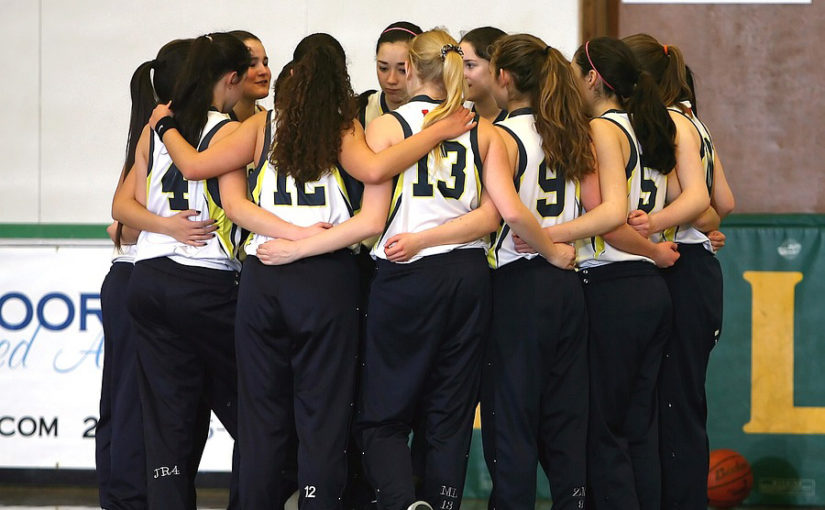Coach Throwback: Nick Nurse’s out-of-bounds series
Throughout the year, Coach & Athletic Director will go back 25 years to share some of our best articles from 1994. The publication, formerly Scholastic Coach magazine, is closing in on 89 years of production. What better way to celebrate our longevity in the team sports industry than to show what we’ve done and where we’ve been.
This article was written by Toronto Raptors head coach Nick Nurse when he was an assistant coach at the University of South Dakota. In it, Nurse breaks down an out-of-bounds series that had proven successful with the men’s basketball team.

Three plays with nine options, and two extra plays that work against any defense
You have the ball out of bounds underneath the basket.Wouldn’t it be nice to have a number of plays off of one call?
Wouldn’t it be nice to have a play that can work even if you have been thoroughly scouted?
Wouldn’t it be nice to have a play reads the defense and gives you option against anything the defense can throw at you?
No problem — try the five-in-one out-of-bounds series.
The diagrams show how we normally align. All the positions are interchangeable, making the play more “unscoutable.”
In these plays:
- 1 is your best decision-maker and passer. Also has to be able to shoot, as he will be coming off a screen now and then.
- 2 is the best 3-point shooter. Will set backscreens, shoot 3s and catch a lob.
- 3 is primarily a screener. Also will roll for jump shots.
- 4 is able to score around the basket, shoot the 3, pass and screen.
- 5 is able to score around the basket. Gets a backscreen twice. Also screens and must be able to handle a lob pass.
Play one
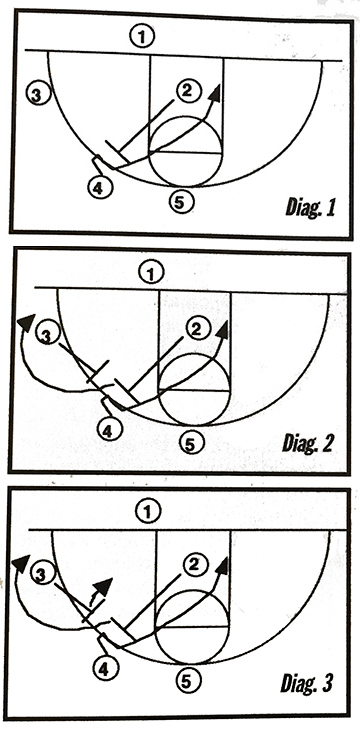
The series is essentially made up of five plays that work off the call “24,” since the series starts with 2 screening for 4.
DIAGRAM 1: 2 backscreens for 4, who drives for the pass (from 1) and layup..
DIAGRAM 2: 3 screens for 2, who, after screening for 4, in the first option, comes off of 3’s screen for the outlet pass (from 1) and 3-point shot.
DIAGRAM 3: 3 rolls for the hoop in case of long help or a defensive switch on 2. 3 can wind up with a nice 12-foot jump shot.
That makes three options off just one play.
Summing up: Early on you will get the back cut and layup. Then, 2’s man will begin offering long help on the back cut. We will then look for the 3-point shot from 2. After 2 hits a couple of 3-pointers, 3’s man begins helping or switching to stop the play. We’ll now hit 3 on the roll back. As you can see, “24” is a very tough play to shut down completely.
» ALSO SEE: John Wooden shares his fast-break offense
We make sure that 2 does not begin hurrying. He has to set a good backscreen and then come off the screen. Timing is important.
Play two
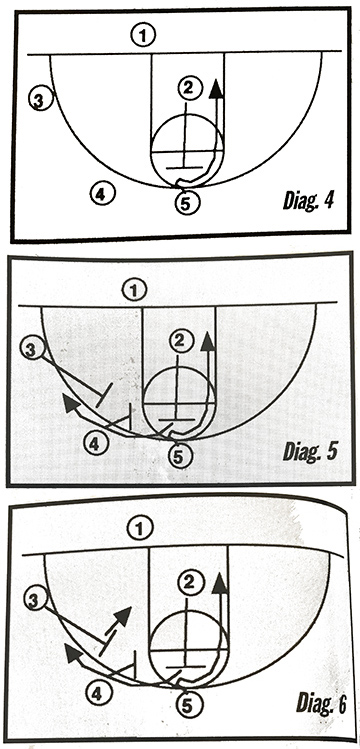 To make things more difficult for the defense, we now add Play 2 to the series. As soon as the defense starts getting used to the diagonal screen being set up by 2, 2 can go to an option: Switch to a vertical screen for 5, shown in Diagram 5.
To make things more difficult for the defense, we now add Play 2 to the series. As soon as the defense starts getting used to the diagonal screen being set up by 2, 2 can go to an option: Switch to a vertical screen for 5, shown in Diagram 5.
This play does not have to be called. 2 decides it by the way he goes diagonal, as in play one, or vertical, as in play two.
DIAGRAM 4: This is the first option after 2’s vertical screen. 5 cuts off the backscreen and drives in for the pass and layup.
DIAGRAM 5: 3 and 4 set backscreens for 2, who cuts around them for the outlet pass and 3-point shot.
DIAGRAM 6: If 2 cannot get the ball because of long help or a switch, 3 must again roll to the hoop off of his screen and look for the pass and open 12-foot shot.
As you can see, play two progresses like play one. After the play is run a few times, the defense will start looking for the diagonal screen by 2. 2 will then set the backscreen for 5, who has not done much to this point, and 5 will break sharply to the hoop for the layup.
We are now ready to move on to another play. When the defense starts sagging off 4 to bollix up the screens and cuts, it will set up play 3 for us. Again, this does not have to be called any differently from others.
Play three
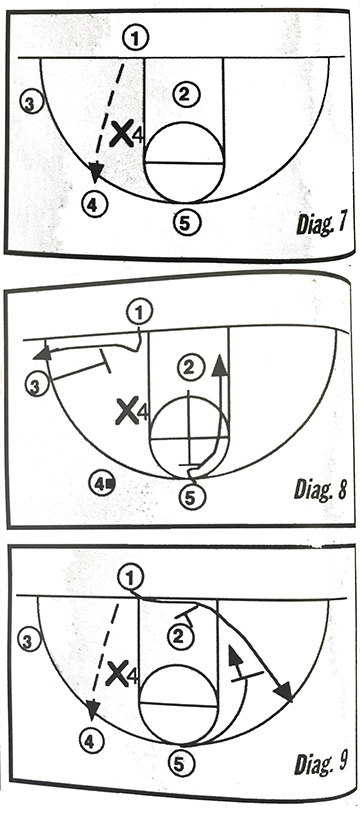 DIAGRAM 7: If 1 spots X4 sagging to the middle, he can make an immediate entry pass to 4. We run our options off this key. Upon receiving the direct entry pass from 1, 4 can shoot the 3-pointer.
DIAGRAM 7: If 1 spots X4 sagging to the middle, he can make an immediate entry pass to 4. We run our options off this key. Upon receiving the direct entry pass from 1, 4 can shoot the 3-pointer.
DIAGRAM 8: If 4 cannot take the shot, the outlet man (1) must step in and go either way off a screen from 3. 4, who has the ball, can hit 1 for the 3-pointer. If 1 does not have the shot, the third option is a lob to 5 coming off of 2’s backscreen.
DIAGRAM 9: If 1 decides to cut up the middle after passing to 4, he must step in and come over 2’s screen and then 5’s screen for a jump shot. 2 clears out from under the hoop and 5 immediately posts up after screening for 1.
If 1 does not have the jump shot, he can look inside for 5 or pull out and start the offense.
Play three has many solid options that make the play difficult to shut down completely.
Bonus plays
We can now move on to the last two parts of the series — extra things that have evolved out of this series. Though simple, they have produced some easy baskets.
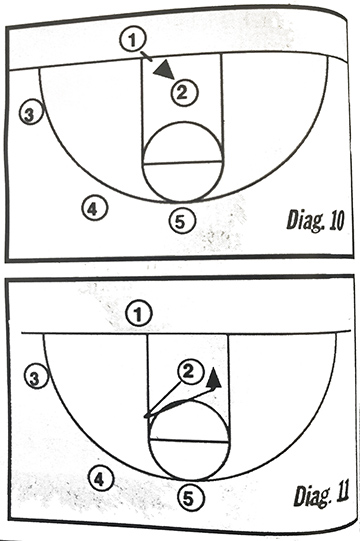 DIAGRAM 10: This is simply a lob for 2 whenever his man becomes so concerned with him underneath that he starts to face-guard him. 2 keys the play by tapping his head right before the ref hands 1 the ball.
DIAGRAM 10: This is simply a lob for 2 whenever his man becomes so concerned with him underneath that he starts to face-guard him. 2 keys the play by tapping his head right before the ref hands 1 the ball.
1 throws the lob right over 2’s defender, who has lost sight of the ball.
If 1 does not think 2 is open, 2 must quickly continue with the play by going diagonally (play one), vertically (play two) or waiting to screen for 1 (play three).
DIAGRAM 11: This is another quick-hitting play for 2. Recall play one where 2 screened diagonally for 4? After this play has been run a few times, and 2 has struck a 3-pointer, 2’s man really starts guarding him aggressively, looking to fight through those screens.
As you can see in Diagram 11, 2 now starts toward 4 as he has done all game, then surprises his man by spinning around and pinning him for the pass and layup. If 2 is not open, 1 can lob the ball out to 4 and run play three or lob it out to 5 as a safety valve.
These last two plays provide a couple of more effective wrinkles to the series.
I believe you can see how difficult it will be to scout or defend this series. It may appear to be complicated at first, but it can be worked into the offense fairly simply.
You will be amazed at the number of scoring opportunities the five-in-one out-of-bounds series will give you.


